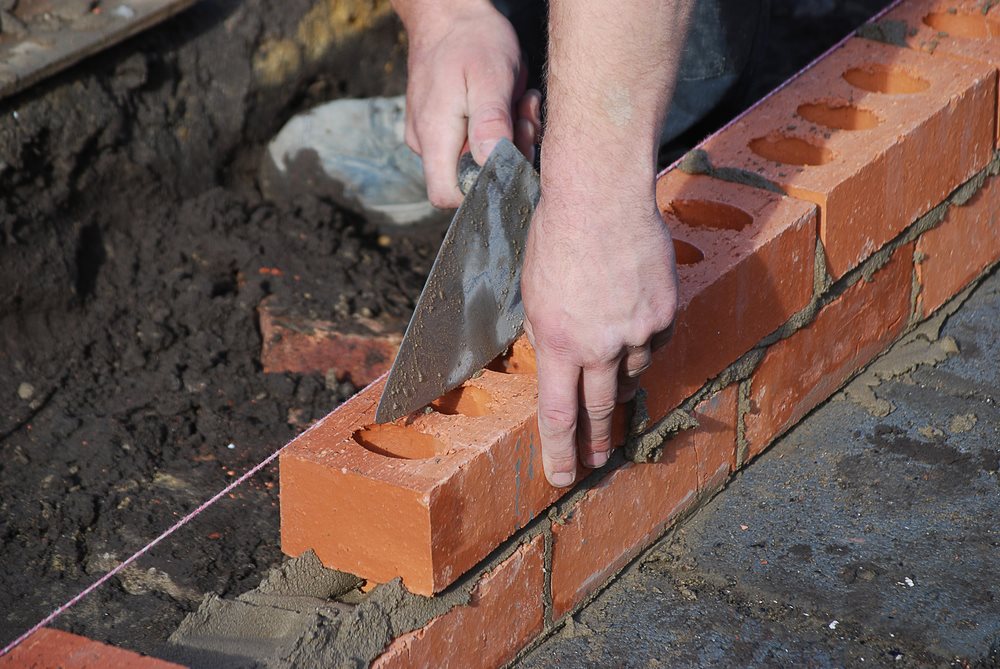Pointing brickwork

When masonry structures are first constructed, mortar is applied as a thick paste which sets hard as it cures, creating a tight seal between bricks and blocks to prevent air and moisture entering into the construction. Depending on the age of the building, the type of masonry, and the nature of the overall wall construction, mortar used for pointing will be either lime mortar or cement mortar.
The finished profile of the mortar joint at is external surface is known as ‘pointing’. This profile can be varied depending on exposure or to create a specific visual effect.
The most common pointing profiles are:
- Flush: The mortar is finished off flush with the face of the masonry units.
- Recessed or raked: Mortar is pressed back from the face of the masonry units by 5 mm or more. This creates a shadow gap between the masonry units.
- Beaded, concave, half round or bucket handle: A more rounded type of pointing with a concave edge. This can look aesthetically pleasing, but it may damage more easily than other profiles.
- Struck or weatherstruck: Similar to flush except the upper edge is pressed back inside the face to create a sloping profile. This is time-consuming and requires practice, but the effect can be aesthetically pleasing.
- Rubbed: Also known as keyed or grooved, this is a rounded groove formed in the middle of the pointing using a suitable tool.
- V-pointing: Similar to rubbed but with a sharp inward V-groove rather than rounded.
- Tuckpointing: Using two colours of mortar (one similar to the colour of the masonry, used at the edges) to give the impression that the joints are very thin.
- Penny roll: A recessed line is created in the middle of the joint to give a tidier impression when the joints are wide or degraded.
- Strap or ribbon: A neat strip of mortar sits proud of the face of the masonry. This can be used to give a neater impression when joints are degraded.
Generally, mortar is structurally weaker than the blocks or bricks it bonds, creating a sacrificial layer that is more easily repaired than defects would be in the bricks or blocks themselves. As a result, mortar joints can decay over time, due to weathering, frost damage, and so on. When this happens, repointing is undertaken to renew them. For more information see: Repointing.
[edit] Related articles on Designing Buildings
Featured articles and news
RTPI leader to become new CIOB Chief Executive Officer
Dr Victoria Hills MRTPI, FICE to take over after Caroline Gumble’s departure.
Social and affordable housing, a long term plan for delivery
The “Delivering a Decade of Renewal for Social and Affordable Housing” strategy sets out future path.
A change to adoptive architecture
Effects of global weather warming on architectural detailing, material choice and human interaction.
The proposed publicly owned and backed subsidiary of Homes England, to facilitate new homes.
How big is the problem and what can we do to mitigate the effects?
Overheating guidance and tools for building designers
A number of cool guides to help with the heat.
The UK's Modern Industrial Strategy: A 10 year plan
Previous consultation criticism, current key elements and general support with some persisting reservations.
Building Safety Regulator reforms
New roles, new staff and a new fast track service pave the way for a single construction regulator.
Architectural Technologist CPDs and Communications
CIAT CPD… and how you can do it!
Cooling centres and cool spaces
Managing extreme heat in cities by directing the public to places for heat stress relief and water sources.
Winter gardens: A brief history and warm variations
Extending the season with glass in different forms and terms.
Restoring Great Yarmouth's Winter Gardens
Transforming one of the least sustainable constructions imaginable.
Construction Skills Mission Board launch sector drive
Newly formed government and industry collaboration set strategy for recruiting an additional 100,000 construction workers a year.
New Architects Code comes into effect in September 2025
ARB Architects Code of Conduct and Practice available with ongoing consultation regarding guidance.
Welsh Skills Body (Medr) launches ambitious plan
The new skills body brings together funding and regulation of tertiary education and research for the devolved nation.
Paul Gandy FCIOB announced as next CIOB President
Former Tilbury Douglas CEO takes helm.
UK Infrastructure: A 10 Year Strategy. In brief with reactions
With the National Infrastructure and Service Transformation Authority (NISTA).






















